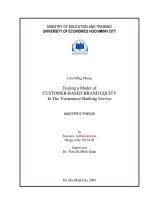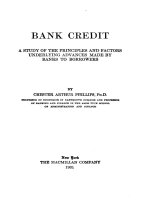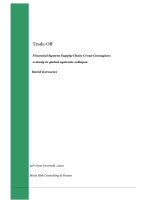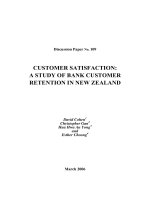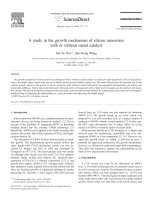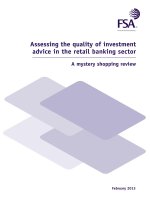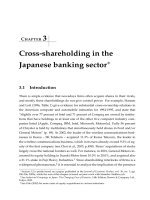Bank choice behavior, customer participation a study in the retail banking sector
Bạn đang xem bản rút gọn của tài liệu. Xem và tải ngay bản đầy đủ của tài liệu tại đây (1.14 MB, 80 trang )
ACKNOWLEDGEMENT
At the first, I would like to thank all those people who made this thesis possible and an
unforgettable experience for my studying. Foremost, I would like to express my sincere
gratitude to my supervisor, Dr. Ngo Viet Liem, for his intensive support, valuable suggestions,
instructions and encouragement during the time of doing my research. His guidance helped me
in all the time of research and writing of this thesis.
Besides my supervisor, I would like to thank the rest of my thesis committee: Prof.
Nguyen Dong Phong, Prof. Nguyen Dinh Tho, and Dr. Tran Ha Minh Quan … for their
encouragement, insightful comments, and hard questions.
I thank my classmates in ISB MBUS 2011 (specially members in my group: Ms. Hanh,
Ms. Hang, Mr. Chuong and Ms. Hien) and my colleagues at Shinhan Bank for their
encouraging and supporting to me complete this thesis. Besides that, my sincere thanks are
given to all of my teachers at International Business School – University of Economics Ho Chi
Minh City for their teaching and guidance during my MBUS course.
Last but not the least, I would like to thank my family. I must express my gratitude to
Phan Thi Hoi, my older sister, for her continued support and encouragement. I also wish thank
all those people who spent through their time and generous support made this thesis project.
Ho Chi Minh City, October, 2014
PHAN DANH HOANG
1
ABSTRACT
This study integrates bank choice behavior and customer participation into a theoretical
framework to explain variation in customer loyalty. Specifically, the purpose of this study is
twofold: (a) to examine the extent to which attributes of bank choice behavior (e.g. search,
experience and credence) influence customer loyalty; (b) and through which mechanism
customer participation influence the relationships between attributes of bank choice behavior
and customer loyalty. The empirical setting of this study is the retail banking sector. A survey
of 466 customers using personal loan services in some domestic banks is conducted.
The findings indicate that bank choice behavior and customer participation play
important role in predicting the loyal of customer who use personal loan services. The results
also support that customer participation is biggest impact to customer loyalty, followed by
credence attributes and experience attributes. Whereby, the banking managers need to consider
creating all of experience attributes, credence attributes and customer participation to make
their customer loyalty to the bank. The research results are limited in the power of
measurement scale, sampling approach as well as the fitness of the research model and data. It
results in the valuable directions for further researches in future.
Keywords
Retail banking, personal loan, bank choice behavior, customer participation, customer loyalty.
2
TABLE OF CONTENTS
ACKNOWLEDGEMENT ..................................................................................................... 1
ABSTRACT ........................................................................................................................... 2
TABLE OF CONTENTS ....................................................................................................... 3
CHAPTER 1 - INTRODUCTION ......................................................................................... 7
1.1 Background to the research .............................................................................................. 7
1.2 Statement of the problem ................................................................................................. 8
1.3 Research questions ........................................................................................................... 8
1.4 Significance of the Study ................................................................................................. 9
1.5 Research scope and delimitation ...................................................................................... 9
1.6 Organization of the thesis............................................................................................... 10
CHAPTER 2 ......................................................................................................................... 11
THEORETICAL MODEL AND HYPOTHESES ............................................................... 11
2.1 Bank choice behavior ..................................................................................................... 11
2.2 Customer participation: .................................................................................................. 12
2.3 Customer Loyalty ........................................................................................................... 15
2.4 Research model and hypotheses development ............................................................... 16
Building upon prior research, Figure 2.2 integrates the focal constructs of the thesis with
hypothesized relationships. ......................................................................................................... 16
2.4.1 Bank choice behavior and customer loyalty ............................................................... 17
2.4.2 Bank choice behavior and customer participation ...................................................... 18
2.4.3 Customer participation and customer loyalty ............................................................. 20
CHAPTER 3 ......................................................................................................................... 22
RESEARCH METHODS ..................................................................................................... 22
3.1. Research design ............................................................................................................. 22
3.2. Development of questionnaire ...................................................................................... 23
3.2.1. Measurement scales.................................................................................................... 23
3
3.2.1.1. Measure of search, experience and credence .......................................................... 23
3.2.1.2. Measure of customer participation .......................................................................... 25
3.2.1.3. Measure of customer loyalty ................................................................................... 26
3.2.2. Draft questionnaire ..................................................................................................... 26
3.3. Pilot study ...................................................................................................................... 27
3.4. Sample method .............................................................................................................. 28
3.5. Questionnaire administration ........................................................................................ 30
3.6. Data analysis methods ................................................................................................... 31
CHAPTER 4 ......................................................................................................................... 32
DATA ANALYSIS AND FINDINGS................................................................................. 32
4.1. Descriptive analysis....................................................................................................... 32
4.2. Reliability analysis ........................................................................................................ 33
4.3. Exploratory Factor Analysis (EFA) .............................................................................. 36
4.4. Confirmatory Factor Analysis ....................................................................................... 39
4.4.1 Composite reliability and variance extracted .............................................................. 41
4.4.2 Unidimensional analysis ............................................................................................. 42
4.4.3 Convergent validity analysis ....................................................................................... 42
4.4.4 Discriminant validity analysis ..................................................................................... 43
4.5. Research model test ....................................................................................................... 43
4.5.1. Theoretical model test by using SEM approach ........................................................ 43
4.5.2. Theoretical model estimation by BOOTSTRAP........................................................ 46
CHAPTER 5 ......................................................................................................................... 48
DISCUSSION, IMPLICATIONS AND LIMITATION ...................................................... 48
5.1. Discussion .................................................................................................................... 48
5.2. Implications of the research .......................................................................................... 49
5.3. Limitations and directions for further research ............................................................. 51
REFERENCES ..................................................................................................................... 53
4
APPENDICES ...................................................................................................................... 61
APPENDICES
APPENDIX 1 - Questionnaire ............................................................................................. 61
APPENDIX 2 - The results of population census 2009 in Ho Chi Minh City .................... 67
APPENDIX 3 - The result of EFA analysis – Eigenvalues for variables (the first test) ..... 67
APPENDIX 4 - CFA test result............................................................................................ 72
LIST OF FIGURES
Figure 2.1 - Totally disaggregated second-order model of bank choice behavior ............... 12
Figure 2.2 - The proposed research model with hypotheses ................................................ 21
Figure 3.1 - Research process .............................................................................................. 23
Figure 4.1 - CFA result in the second time (Standardized estimates).................................. 40
Figure 4.2 - Result of hypothesis test in the second time..................................................... 45
Figure 4.3 - The result of CFA in the first time (Standardized)........................................... 72
LIST OF TABLES
Table 3.1 - Measurement scales of bank choice behavior ................................................... 24
Table 3.2 - Measurement scales of customer participation .................................................. 25
Table 3.3 - Measurement scales of customer loyalty ........................................................... 26
Table 3.4 - calculating sample with quota sampling method ............................................... 29
Table 4.1 - Descriptive statistic of respondent’s characteristics .......................................... 32
Table 4.2 - Descriptive statistic of respondent’s characteristics .......................................... 33
Table 4.3 - Cronbach’s alpha reliability coefficient............................................................. 34
Table 4.4 - Cronbach’s Alpha coefficients for each measurement scale ............................. 34
Table 4.5 - The EFA analysis result ..................................................................................... 37
Table 4.6 - Cronbach’ Alpha results after excluding unsatisfactory items .......................... 38
5
Table 4.7 - Modification indices .......................................................................................... 39
Table 4.9 - Discriminant validity of concept ....................................................................... 43
Table 4.10 - Regression Weights ......................................................................................... 44
Table 4.11 - Regression Weights: (Group number 1 - Default model)................................ 45
Table 4.12 - The results for Bootstrap estimation ................................................................ 47
6
CHAPTER 1 - INTRODUCTION
1.1 Background to the research
The Vietnamese banking sector is transforming at a rapid pace and is expected to show a
higher growth rate than most of its counterparts in neighboring Asian countries in the
upcoming years (Ho and Baxter, 2011). This tendency has been mainly shaped by state-headed
economic reconstructions since the end of the 1980s and the creation of several State-Owned
Commercial Banks (SOCB). It has accelerated recently with the country’s accession to the
World Trade Organization in 2007, heading to a dynamic liberalization of the banking sector.
These reforms and the tremendous economic development of the country during the last two
decades (Breu and Dobbs, 2012) are making important chances for both national and foreign
banks operating in Vietnam, mainly in retail banking sector.
Since early 2014, although interest rates for enterprises were fall down in the lowest
level since the stimulus package in 2009 of Government, but the credit growth is still difficult
to increase. Many enterprises still hesitate to get loans. So many banks shift their emphasis to
personal loans services to grow credit outstanding balance. In particular, personal loan services
attracted attention from many individual customers by simple and convenient procedures. The
success of retail banking sector depends on the type of relationship maintained with its
customer and an understanding of customer needs. In the commercial banking industry there is
a growing recognition that individual customers not only represent a viable market segment but
that their needs are different and frequently changed.
One strategic tool that banks can use to attract new customers, retain current customers
and develop strong relationships is the customer loyalty. Customer loyalty is one of key
concerns for researchers and marketers who are interested in understanding its predictors and
causal structure. Previous research on this concept also showed that customer participation
leading to loyalty (Auh, Bell, McLeod& Shih, 2007; Ngo &O'Cass, 2013). It gives the notion
that customer participation is very important concept for marketers and managers.
7
Besides the customer loyalty, bank choice behavior attributes (search, experience,
credence) also attract many of researchers (Mitra, Reiss, and Capella, 1999; Babakus,
Eroglu&Yavas (2004). However, few empirical studies investigate the relationship between
bank choice behavior contributes, customer participation and customer loyalty. This study
therefore develops a model examining the role of bank choice behavior, customer participation
on customer loyalty. Empirically, it tests the impact of bank choice behavior attributes on
customer participation. Then, it investigates the impact of bank choice behavior contributes and
customer participation on customer loyalty. Following this introduction, the next section
presents statement of the problem.
1.2 Statement of the problem
The demand for personal loan products has been increasing dramatically. However,
banks still do not have an optimal recipe for attracting new customers, retaining and selling
more services to existing customers. A study on the effects of bank choice behavior and
customer participation on customer loyalty will allow bank managers to have an appropriate
marketing strategy to attract new customers. It can help bank managers give out methods which
help to increases the level of customer loyalty, thereby maintaining the existing customers.
Through studying the relationship between customer participation and customer loyalty, it also
allows bank managers find out ways to strengthen the participation of the customer in the
transaction process through which banks can increase the level of customer loyalty.
1.3 Research questions
The purpose of this research is to empirically investigate the impact of bank choice
behavior and customer participation on customer loyalty. The empirical setting in this
particular research is the retail banking sector in the transitional economy in Vietnam. Contrary
to the past, many customers are trying to use personal banking services and have a lot of
products to choose. Given this situation, a study of bank choice behavior, customer
8
participation and customer loyalty would be very useful. This study attempts to answer the
following research questions.
To what extent, do attributes of bank choice behavior (e.g. search, experience and
credence) and customer participation influence customer loyalty?
Between bank choice behavior and customer participation, which factor will most
influence to customer loyalty?
1.4 Significance of the Study
This study has important implications for both practitioners (leaders of commercial
banks, marketing managers) and academic (researchers, students of the business administration
department) as follow:
The findings of this study contribute to research on bank choice behavior and
customer participation by investigating the contribution of both bank choice behavior
and customer participation to enhancing customer loyalty. Based on it, managers of
commercial banks will make an effective strategy to enhance customer loyalty and
improve operational efficiency.
Marketing managers will consider the factors of bank choice behavior which
affect customer loyalty in personal loan market sector to set up an appropriate
communicate strategy. The results of this study also are a basis for researchers, students
for developing further research to practical applications.
1.5 Research scope and delimitation
This study is conducted in Ho Chi Minh City, one of the biggest economic centers of
Viet Nam. Respondents are customers who are using personal loan services at banks. Due to
limited time and cost, the research surveyed about 500 customers of large domestic commercial
banks in HCMC. The result of research in this city, in some level can represent for Viet Nam in
general and can be use as reference for further purposes.
9
The research will assess the effect of bank choice behavior attributes and customer
participation to customer loyalty. In this, the quota sampling method is used to collect research
data. It is a type of the non-probability sampling. Althought selected-sample is not generalized
to population, if we choose the right controlled characteristic (distinguishing attributes of
studied objects), in theoretically, sample cannot represent for population but in practice it may
represent for population.
1.6 Organization of the thesis
This thesis is organized in five chapters. The first chapter is the introduction that
describes the overview of research background, research problem, and objective, followed by
the scope of research, implications, and structure of thesis.
Chapter 2 reviews previous research on customer loyalty and customer participation.
Specifically, the chapter reviews the mediating role of customer participation model and theory
of bank choice behavior and, how they are used in various contexts. This chapter concentrates
on explaining each variable in the model, and reasons for choosing them to be included in the
research model.
Chapter 3 introduces research methodology used to validate the research model in
previous session. It presents the research design, development of survey questionnaire,
qualitative study, and main survey. This chapter also presents how to collect data and analyze
the data collected to test the research hypotheses proposed in chapter 2.
Chapter 4 analyses data as well as discusses the result finding in connection with
research model. This chapter explains the empirical part of the study. This part discusses the
analyses of the data received, psychometric properties of focal constructs, and hypothesis
testing.
The last chapter, chapter 5 discusses implications and research limitations. Finally, this
thesis makes suggestions for further research on the topic area.
References and appendixes are included in the end of thesis.
10
CHAPTER 2
THEORETICAL MODEL AND HYPOTHESES
This chapter provides a theoretical background about bank choice behaviour, customer
participation, customer loyalty, upon which a conceptual research model and hypotheses are
constructed.
2.1 Bank choice behavior
The underlying theory of the bank choice behavior model was first developed within the
economics of information literature (Darby and Karni, 1973; Nelson, 1970) and later refined
within the services context (Bloom and Pailin, 1995; Lynch and Schuler, 1990). Three sets of
attributes are hypothesized to be manifestations of a consumer’s choice decisions: search,
experience and credence (Mitra et al., 1999) as shown in Figure 1. Search attributes are those
that are accurately evaluated before making a choice decision (Srinivasan and Till, 2002)
According to Babakus at al., (2004), search, experience and credence can defined as follows:
Search attributes – which may be accurately evaluated before making a choice.
Within the banking context, these include interest rates on deposits or loans, overdraft
privileges, fees and charges, working hours and new bank services.
Experience attributes – which may be accurately assessed only when the service
has been purchased and used. Within the banking context, these include the helpfulness of
tellers, the supply of services with a timely manner, the attentiveness of bank employees,
their temperament to pay attention to the client, their friendliness and expertise, and the
speed of decision made by the bank authorized person.
Credence attributes – which can or might not be evaluated even when a sale is
created, simply because the client might lack the technical experience needed to create the
assessment or there may be without delay accessible indicators of the attributes. Within the
banking context, credence attributes consist keeping the client’s banking information
11
confidential, the integrity of the bank, and adoption of bank in receiving of the most recent
technology, its management and its overall ability inside the business of banking.
Figure 2.1 - Totally disaggregated second-order model of bank choice behavior
2.2 Customer participation:
Many different theories focus on how to increase customer actively engaged in services
production and distribution (Auh at al., 2007; Yi at al., 2011). The study of Firat at al., (1995)
pointed out that customer participation in the company can contribute to create new services in
accordance with their own needs. In addition, the involvement of customers allows the
company to create long-term relationships between companies and customers (Bendapudi &
Leone, 2003; Payne at al., 2009). In fact, companies tend to focus on encouraging customers to
take part in spreading positive word of mouth. The reason is when companies invite customers
to share their views with managers; this activity will make them become brand evangelists.
12
Most managers grasp that paying attention to customers makes sensible business sense. Banks
have abundant to achieve from actively seeking and inspiring client participation, that banks
have a tendency to outline as obtaining customers to supply constructive suggestions and share
their concepts on the way to form product and repair offerings. Nonetheless whereas the
thought that soliciting and listening rigorously to customers is recent, several corporations
solely pay lip service to it. The return on customer participation is higher than several managers
suppose.
Dabholkar (1990) considered customer participation as involved level of customers in
the production and supply of services. Integrating customers into the innovation process of
companies will help companies improve and enhance the quality of service and success in the
market. Dagger & Sweeney (2007) also claimed that improving service quality in the service
industry is the top priority because high quality services not only increases the positive
intention of customers behavior but also contribute to improved market share, revenue and
greater profitability.
Lengnick-Hall et al., (2000) suggested that customer participation is the involving of
customer as an active participant in the work of the organization. This view has two main
benefits. First, the integrated clients in customer engagement can help organizations reduce
costs (e.g. after customers use banking services, they discovered the irrational in the process
transactions, they raised these issues with bank managers, to collect opinions and adjustment
processes transactions of banks will help to reduce transaction errors and transaction time, this
obviously helps banks to cut staff costs, reduce transaction time, increased customer
satisfaction). Besides that, customer participation can help reduce the price of products and
services (e.g. cost and price are both normal covariates, the customer participation help banks
cut costs as well means helping organizations improve profitability, and the considering service
discounts will be considered in order to increase competitiveness, attract customers of the
bank). In line with this view, Mills et al., (1983) also said that customer participation lead to
increase productivity for organizations. Second, customer participation facilitates the bank to
13
customize its offerings to customers’ desires. The private interaction between the consumer and
the bank consequently represents a vital part of a service delivery method within which the
client has direct input into the assembly of the ultimate service. High-contact services, like
money, legal, and medical services, are outlined by a high degree of coupling (i.e., continuous,
immediate impact of contact), interdependence (i.e., service quality is conditional inputs from
every party), and knowledge richness (i.e. the worth of knowledge passed between parties)
(Kellogg and Chase, 1995). The advantages of client participation do not seem to be restricted
entirely to high-involvement services though; even in low- and moderate-involvement services,
clients could notice customer participation enticing because they fancy magnified perceived
management over the service delivery method (Bateson, 1985) and extra opportunities to create
selections that offers them higher levels of customization (Schneider and Bowen, 1995).
Bendapudi& Leone (2003) and Ravald&Gronroos (1996) said that customer
participation represent for things which the company could do with clients to co-create value.
Customers can search and see the benefits of it to make their impact on different parts of the
worked system to build shopping and consumer experience of his own personal
(Prahalad&Ramaswamy, 2004). Besides, customer participation not only helps the company
consume products or services but also help companies change and improve products/services
quality. Therefore, customers are increasingly encouraged to actively cooperate with the
company to create better value on the basis of mutual benefit.
According to Krajewski at al., (2010), the involvement of the customer is not always the
best option, but is accompanied by the disadvantages. Allowing customers play an active role
in the service process may create trouble and makes the process less efficient. The management
of time and volume of customer needs can be difficult and challenging. Measuring service
quality also becomes more difficult. Costs for businesses could rise due to the layout of skilled
personnel to better interact with customers. However, the benefits of active participation in the
process can increase customer value for themselves. Some clients seek active participation and
control services process, especially if this participation saving both time and cost. More client
14
involvement will mean higher quality, quicker delivery, bigger flexibility, and even lower
price. Self-service is that the selection for several retailers, like supermarkets, gas stations and
bank services.
Encouraging customer participation will make the most customer competencies
throughout the course of their innovation activities (Blazevic&Lievens, 2008). To inspire
customers’ participation, enterprises may set-up and on-going relationship and work closely
with customers to confirm meet customer needs. During this sense, customer is thought as
active partners within the creation of innovative offerings. Consequently, to amass superior
service quality for the client, corporations ought to be ready to develop new strategies (e.g.
social control and promoting innovations) to encourage customers to participate, in addition as
strategies to success monitor and manage the process along the way.
2.3 Customer Loyalty
Customer loyalty refers to the trend to hold favorable attitudes to the services / products
and undertaking to acquisition and / or use of services / products (Bowen and Chen, 2001).
Marketing researchers agree that in most of situation customer loyalty for a brand is more
important than customer satisfaction (Cooil et al, 2007; Pleshco and Baqer, 2008). In the other
hand, loyalty can make customers easy to forgive in a disappointing situation associated with a
certain brand or to a store (Shankar et al., 2003).
In the opinion of Bendapudi & Berry (1997), even though the research literature of
customer loyalty is done with the different aspects, the two most popular views are the
behavior and attitudes. In particular, the first approach of loyal is to meaning as repeat purchase
behavior. However, there is also the idea that customers can eliminate repeat purchase behavior
out of their habit because a number of barriers prevent them from changing suppliers or
because of a lack of attractive options or services instead. In this respect, customers can
maintain loyalty as obligations, developed a type of faked loyalty without any good feelings
15
with their suppliers. The second approach is the considering of loyalty as a psychological state
(emotional and or cognitive) that customers can achieve as a result of supplier’s relational
strategies. Customers may voluntarily maintain relationships based on the benefits they receive
in this relationship (Caruana, 2004). This approach supports the view that the foundation of
loyalty is actually a positive attitude to the supplier and ensures repeat purchasing behavior in
the future. With the benefits that customers receive loyalty of customers to suppliers is derived
from themselves to maintain this relationship (Oliver, 1999).
In order to generalize the two approaches as Gremler at al., (2001) suggested, this study
considers loyalty to a particular supplier as a multidimensional concept. In which, loyalty refers
to the extent to which customers expressed their intention to purchase again in the future
(intention future behavioural), showing a positive attitude to suppliers (affective loyalty) and
see vendors as an unique option for the needs arising in the future (cognitive loyalty). Derived
from two perspectives on loyalty, managers were given two main strategies to enhance
customer loyalty. The first strategy is to satisfy customers and provide them with the products
and services which make they feel satisfied so that their desire to maintain this satisfaction. The
second strategy is to establish barriers to prevent conversion process of customer to a new
provider (Balabanis, Reynolds, and Simintiras, 2006). If the customer is aware that the
provision of products and services on the market are homogeneous, there is little difference,
they will not be combined with any benefits to changing providers. The result is the tendency
to abandon the relationship will be reduce and increase the level of loyalty (Balabanis et al.,
2006).
2.4 Research model and hypotheses development
Building upon prior research, Figure 2.2 integrates the focal constructs of the thesis with
hypothesized relationships.
16
2.4.1 Bank choice behavior and customer loyalty
Nelson (1970, 1974) and Darby and Karni (1973) extended the concept of search,
experience and belief in the economic information theory of Stigler (1961) by questioning how
the various types of attributes interact with the customer search and experience. Accordingly,
there is a distinction between search and experience attributes. Search attributes is something
that customers can confirm before purchase via directly check or based on the source of
available information. While experience attributes are things that customer can only get after
using the product (Ford et al., 1990). On the other hand, according to Darby and Karni (1973),
credence attributes are things that very difficult for customer to verify even after using. A
product or service can have one, two or three types of attributes. For example, in the case of
personal loan services: search attribute is interest rates, experience attribute is a professional in
service, and credence attribute will be integrity of staff. Three types of properties are very
useful in checking customer disbelief (Ford et al., 1990, Smith, 1990), marketing information
contents (Norton and Norton, 1988), trust evaluation and confidence (Wright and Lynch,
1995), and the important role of price in making choice services (Ostrom and Iacobucci, 1995).
Customer loyalty usually is created after customers feel satisfied with the services that
banks provide. Therefore, customer loyalty will be not established before they experience the
product. In the case of search attributes (such as interest rate, overdraft privileges), consumers
are able to inspect the services and draw inferences about the attribute before actually
purchasing the service, and consumers are least skeptical of search claims (Ford et al., 1990).
Hoch and Ha (1986) showed that search attributes are relatively unambiguous in the theory of
information diagnosticity and ambiguity. Therefore customers are most likely to review their
cognitive framework that services quality of this bank is better or worse than that bank to
generic products while evaluating search attributes. Therefore, this study hypothesizes that the
change of search attributes effect on customer loyalty.
Hypothesis 1: There is a positive effect of search attributes on customer loyalty.
17
As discussed above, in opposition to aspects of search attributes, experience and
credence attributes are not easily confirmed before customers use a product or service that
(Darby and Karni, 1973; Nelson, 1974). Also in the opinion of Kirmani and Wright (1989);
Shapiro (1983); Wernerfelt (1988), customers must use a specific product / service to assess
attributes and draw their own experience. If customers want to evaluate the product before use,
they will have to rely on other features to draw conclusions about the quality of
products/services. Another problem is that customers can not clearly evaluate credence
attribute even after using products/services. So, in the absence of any other indication,
customers tend to evaluate credence attributes based on the customer perception. Before using
the service, customers often evaluate it based primarily on their basis perception of the service.
However, after the customer has got the opportunity to try the service, they have extra
information to associate with their inference perception of its quality. If a same services and
differing only in name of bank, trial would be expected to reduce the attitudinal loyalty for the
service of bank have a low quality and increase the attitudinal loyalty for the service of bank
have higher quality. Therefore, the study hypothesizes that experience and credence attributes
will have a positive effect on customer loyalty.
Hypothesis 2: There is a positive effect of experience attributes on customer loyalty.
Hypothesis 3: There is a positive effect of credence attributes on customer loyalty.
2.4.2 Bank choice behavior and customer participation
Experience represents a customer’s accrued knowledge about how a service should
perform and general understanding of the average value of similar services in a different
provider. Experience likely increases client involvement of the customer for several reasons.
First, as customers gain more experience in the type of product, they can better evaluate where
they would make a contribution. Moorthy et al. (1997) similarly argue that as customers gain
experience, they are better able to evaluate the various attributes of different service offerings.
In other words, customers who have a high level of experience are better equipped to make
18
valuable contributions to the production of a service and hence more likely to do so. Second,
inexperienced customers typically perceive higher decision-making risk (Heilman et al. 2000).
These customers are less likely to involve themselves because they fear producing a suboptimal
outcome. Third, experienced customers likely have a greater need for control in the service
delivery process (O’Connor and Siomkos, 1994). Therefore, the need to control or influence
the outcome of a service will increase expert customers’ likelihood of getting involved in
production.
In the chain of bank choice behavior, customer joins all of the process from search,
experience, to credence. The interactive process creates the communication between client and
bank staff. Sharma and Patterson’s (1999) define communication as the formal and informal
sharing of meaningful and timely information between a client and advisor in an empathetic
manner. The content of communication, in the financial context of our study, focuses on
encourage clients participate in the loan process, interacting with bank staff to search services
information, response their understanding about the products and the responding of bank staff
to client for requesting information. Communication flow is central to the establishment of
strong relationships; it builds trust by resolving clients’ queries and concerns and managing
their expectations (Sharma and Patterson, 1999). Accordingly, author expects bank choice
behavior chain between the advisor and the client will increase the incidence of customer
participation because of their greater willingness to share (potentially sensitive) information.
Accordingly, the study hypothesizes:
Hypothesis 4: There is a positive effect of search attributes on customer participation.
Hypothesis 5: There is a positive effect of experience attributes on customer
participation.
Hypothesis 6: There is a positive effect of credence attributes on customer participation.
19
2.4.3 Customer participation and customer loyalty
Customer participation is defined as constructive customer participation in the service
creation and delivery process and clarify that it requires meaningful, cooperative contributions
to the service process. In the delivery of financial services, such contributions might involve
client preparation prior to meetings with advisors, client provision of input to decision making
processes, and timely and accurate responses to advisor requests for information.
Customer participation likely yields several benefits for customers, including lower
prices, more opportunities to make purchasing, and larger discretion about the configuration of
the ultimate product. Moreover, clients likely experience shorter waiting times and enjoy a
greater likelihood of customization. The relationship between customer participation and
perceived value, however, may not be unequivocally positive (Lengnick-Hall, 1996).
Enterprises have less control over the training of customers to participate effectively in the
production process than they do with service employees. In turn, customer involvement may
raise the overall level of uncertainty in the transaction and thereby affect outputs. Furthermore,
customers may dislike the level of effort required to co produce a service and therefore
abdicate their role in the service process (Solomon, 1986). On balance, however, customers
likely consider being involved in a service creation process as a source of value, especially in
the emerging era of connected, informed, empowered, active consumers (Prahalad and
Ramaswamy, 2004). Dellande et al. (2004) recently demonstrated that customer complianceone facet of customer participation-relates significantly to customer satisfaction, and efforts by
organizations to involve clients in customer participation lead to increased mutual
understanding (Mohr and Bitner 1991). Such mutual understanding results in positive
emotional responses to the service (Price et al., 1995). Moreover, according to the view that
satisfaction results from both cognitive and affective assessments of service experiences
(Westbrook, 1987), repeated positive emotional experiences ultimately contribute to the sort of
customer satisfaction that underpins customers’ decisions to be loyal to an organization (Lam
et al., 2004). Therefore, the study incorporate measures of attitudinal and behavioral loyalty
20
(Dick and Basu, 1994; Wallace et al., 2004). Attitudinal loyalty refers to a measure of clients’
intentions to stay with and level of commitment to the organization, whereas behavioral
loyalty, in the financial services context, is an objective measure of the amount of brokerage
the client paid to the firm in the year following the administration of the questionnaire. Taking
these measures of loyalty into consideration and on the idea of the preceding arguments, the
study hypothesizes:
Hypothesis 7: There is a positive effect of customer participation on customer loyalty.
Figure 2.2 - The proposed research model with hypotheses
21
CHAPTER 3
RESEARCH METHODS
This chapter discusses research methodology and methods for data collection and data
analyses. It presents the research design, development of survey questionnaires, qualitative
study, and main survey. This chapter also presents the data collection procedure and data
analysis methods for testing the research hypotheses proposed in chapter 2.
3.1. Research design
The research design of this study includes two phases. The first phase, qualitative
research identifies the models, factors, suitable measurement variables for research in HCMC.
Through the previous relevant researches, the questionnaire was built then running the pilot test
for checking the efficiency and the meaning of the questions. The pilot test was purposed to
explore and define the relevant items and building a completed questionnaire. The second
phase, quantitative survey was the main approach of this study. The goal is to examine the
effect of bank choice behavior and customer participation on customer loyalty in the personal
loan services of retail banking sector.
Research process includes the steps as illustrated in Figure 3 (Steiger, 1990; Albright,
2006; Schumacker at all, 2006)
22
Figure 3.1 - Research process
3.2. Development of questionnaire
3.2.1. Measurement scales
The measurement scales used in this study is multi-item five point Likert scales, which
were well-established in the extant literature.
3.2.1.1. Measure of search, experience and credence
Bank choice behavior consists of twenty-one items capturing three components (eight
items for search, seven items for experience and six items for credence). These items refer to
the application of knowledge in bank choice behavior generating from the literature (Babakus
23
at al., 2004; Devlin, 2002). This construct will be measured on a five-point Likert scale with
scale poles ranging from strong disagree to strong agree.
Table 3.1 - Measurement scales of bank choice behavior
Construct
Coding of
SA1
SA2
SA3
Search
attributes
Items
variables
SA4
SA5
SA6
1. I always search interest rates on loans information of
banks before I make decision of using services.
2. I usually ask banks what is the type of collateral the
bank will accept to secure my loan?
3. I usually ask banks whether they willing offer me an
overdraft privileges account (unsecured).
4. I usually compare fee structure between banks when I
use their services.
5. I always consider bank transaction hour whether it
fixes with my times to do transaction at banks.
6. I usually make a research if banks have got new
services which have advantages for me.
7. I consider whether branch location near my house or
SA7
not.
8. I consider the bank that I use personal loan services is
SA8
EA1
attributes
attentiveness.
Collateral requirements
Overdraft privileges
Fees structure
Banking hour
New bank services
Branch location
Image/reputation
friendliness and attentiveness
2. Bank X provides services in a timely manner.
Timely manner of service
provision
EA3
3. Bank X’s staffsare always willing to listen to me.
Willingness to listen
EA4
4. Bank X’s staffs present their professional in all
services.
expertise
EA5
5. Bank X gives me a specific period for my application.
approval period for application
EA6
6. Bank X serves me quickly and efficiently.
Speed of dicision
EA7
Credence
1. Bank X’s staffs serve me with friendliness and
Interest rate
EA2
Experience
attributes
a well-known or little-known
Short describe
CRE1
7. Bank X does not require me so much un-need
documents
1. I think that bank staff always has up to date knowledge
of bank products.
24
Absence of bureaucratic
procedures
Up to date knowledge of bank
products
2. I feel that bank staff always show their integrity when
CRE2
I take transaction at bank.
3. I see that bank staff has got knowledge of the market
CRE3
when they converse with me.
4. I believe that bank staff always keeping my private
CRE4
information in safely status.
5. When I use services at my bank, bank staff usually
CRE5
introduces to me new technological advancements.
6. I believe that my bank has enough competence in the
CR6
business.
Integrity of loan officer
Knowledge about the market
Information confidential
Help customer up date new
technological advancements
Competence in the business of
banking
3.2.1.2. Measure of customer participation
Customer participation consists of six items. These items refer to the application of
knowledge in customer participation from the literature (Ngo & O'cass, 2013; Auh at al., 2007;
Chan at al., 2010). This construct will be measured on a five-point Likert scale with scale poles
ranging from strong disagree to strong agree.
Table 3.2 - Measurement scales of customer participation
Construct
Coding of
Items
variables
1.
CP1
Short describe
I spent a lot of time sharing information about my
needs and opinions with the staff of bank X
Sharing information
during the service process.
2.
CP2
needs to the staff of bank X during the service
Showing needs
process.
Customer
participation
I put a lot of effort into expressing my personal
CP3
CP4
3.
X for improving the service outcome.
4.
I have a high level of participation in the service
using process of bank X.
5.
CP5
I always provide suggestions to the staff of Bank
Suggestions for improving
Level of participation
I am very much involved in deciding how the
services should be provided when dealing with
bank X.
25
Affect to providing services
